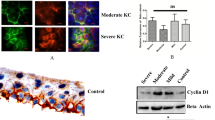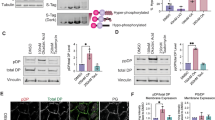Abstract
Phosphotyrosine proteins involvement, particularly cortactin, was studied in cell–cell contacts of cultured bovine corneal endothelial (BCE) cells. These proteins, including α-catenin, vinculin and cortactin, are localized at cell–cell contacts separate from the cortical actin ring. Approximately 50% of cortactin isoforms p80 and p85 were associated with the Triton-insoluble fraction while phosphotyrosine proteins were in the soluble fraction. Disruption of cell–cell contacts by EDTA treatment was associated with a decrease in cortactin isoforms p80 (26%) and p85 (57%). Cortactin isoform p85 was phosphorylated at Y466, expressed in reattaching cells and associated with the Triton-soluble fraction, whereas cortactin isoform p80 was phosphorylated at Y421 and associated with the Triton-insoluble fraction. In sub-confluent cultures, pY421-cortactin was localized at the leading edge and pY466-cortactin at a perinuclear area. In confluent cultures both pY466- and pY421-cortactin isoforms were localized at the cell–cell contacts. In conclusion, in BCE cells, the most prominent appearance of cortactin was at the cell–cell contacts separate from the cortical actin ring. Isoform p80 was phosphorylated at Y421 and associated with the Triton-insoluble fraction and isoform p85 was phosphorylated at Y466 and associated with the Triton-insoluble fraction.





Similar content being viewed by others
References
Bek S, Kemler R (2002) Protein kinase CKII regulates the interaction of beta-catenin with alpha-catenin and its protein stability. J Cell Sci 115:4743–4753
Bershadsky A (2004) Magic touch: how does cell–cell adhesion trigger actin assembly? Trends Cell Biol 14:589–593
Bowden ET, Barth M, Thomas D, Glazer RI, Mueller SC (1999) An invasion-related complex of cortactin, paxillin and PKCmu associates with invadopodia at sites of extracellular matrix degradation. Oncogene 18:4440–4449
Burridge K, Turner CE, Romer LH (1992) Tyrosine phosphorylation of paxillin and pp125FAK accompanies cell adhesion to extracellular matrix: a role in cytoskeletal assembly. J Cell Biol 119:893–903
Cantarelli VV, Takahashi A, Akeda Y, Nagayama K, Honda T (2000) Interaction of enteropathogenic or enterohemorrhagic Escherichia coli with HeLa cells results in translocation of cortactin to the bacterial adherence site. Infect Immun 68:382–386
Clark EA, Brugge JS (1995) Integrins and signal transduction pathways: the road taken. Science 268:233–239
Dardik R, Savion N, Gal N, Varon D (2002) Flow conditions modulate homocysteine induced changes in the expression of endothelial cell genes associated with cell–cell interaction and cytoskeletal rearrangement. Thromb Haemost 88:1047–1053
Dehio C, Prevost MC, Sansonetti PJ (1995) Invasion of epithelial cells by Shigella flexneri induces tyrosine phosphorylation of cortactin by a pp60c-src-mediated signalling pathway. EMBO J 14:2471–2482
Du Y, Weed SA, Xiong WC, Marshall TD, Parsons JT (1998) Identification of a novel cortactin SH3 domain-binding protein and its localization to growth cones of cultured neurons. Mol Cell Biol 18:5838–5851
Dudek SM, Jacobson JR, Chiang ET, Birukov KG, Wang P, Zhan X, Garcia JG (2004) Pulmonary endothelial cell barrier enhancement by sphingosine 1-phosphate: roles for cortactin and myosin light chain kinase. J Biol Chem 279:24692–24700
Gallet C, Rosa JP, Habib A, Lebret M, Levy-Toledano S, Maclouf J (1999) Tyrosine phosphorylation of cortactin associated with Syk accompanies thromboxane analogue-induced platelet shape change. J Biol Chem 274:23610–23616
Gospodarowicz D, Mescher AL, Brown KD, Birdwell CR (1977) The role of fibroblast growth factor and epidermal growth factor in the proliferative response of the corneal and lens epithelium. Exp Eye Res 25:631–649
Head JA, Jiang D, Li M, Zorn LJ, Schaefer EM, Parsons JT, Weed SA (2003) Cortactin tyrosine phosphorylation requires Rac1 activity and association with the cortical actin cytoskeleton. Mol Biol Cell 14:3216–3229
Helwani FM, Kovacs EM, Paterson AD, Verma S, Ali RG, Fanning AS, Weed SA, Yap AS (2004) Cortactin is necessary for E-cadherin-mediated contact formation and actin reorganization. J Cell Biol 164:899–910
Huang C, Ni Y, Wang T, Gao Y, Haudenschild CC, Zhan X (1997) Down-regulation of the filamentous actin cross-linking activity of cortactin by Src-mediated tyrosine phosphorylation. J Biol Chem 272:13911–13915
Huang J, Asawa T, Takato T, Sakai R (2003) Cooperative roles of Fyn and cortactin in cell migration of metastatic murine melanoma. J Biol Chem 278:48367–48376
Kapus A, Szaszi K, Sun J, Rizoli S, Rotstein OD (1999) Cell shrinkage regulates Src kinases and induces tyrosine phosphorylation of cortactin, independent of the osmotic regulation of Na+/H+ exchangers. J Biol Chem 274:8093–8102
Kapus A, Di Ciano C, Sun J, Zhan X, Kim L, Wong TW, Rotstein OD (2000) Cell volume-dependent phosphorylation of proteins of the cortical cytoskeleton and cell–cell contact sites. The role of Fyn and FER kinases. J Biol Chem 275:32289–32298
Katsube T, Takahisa M, Ueda R, Hashimoto N, Kobayashi M, Togashi S (1998) Cortactin Associates with the cell–cell Junction Protein ZO-1 in both Drosophila and Mouse. J Biol Chem 273:29672–29677
Katsube T, Togashi S, Hashimoto N, Ogiu T, Tsuji H (2004) Filamentous actin binding ability of cortactin isoforms is responsible for their cell–cell junctional localization in epithelial cells. Arch Biochem Biophys 427:79–90
Kim L, Wong TW (1998) Growth factor-dependent phosphorylation of the actin-binding protein cortactin is mediated by the cytoplasmic tyrosine kinase FER. J Biol Chem 273:23542–23548
Kinnunen T, Kaksonen M, Saarinen J, Kalkkinen N, Peng HB, Rauvala H (1998) Cortactin-Src kinase signaling pathway is involved in N-syndecan-dependent neurite outgrowth. J Biol Chem 273:10702–10708
Laemmli UK (1970) Cleavage of structural proteins during the assembly of the head of bacteriophage T4. Nature 227:680–685
Li Y, Liu J, Zhan X (2000) Tyrosine phosphorylation of cortactin is required for H2O2-mediated injury of human endothelial cells. J Biol Chem 275:37187–37193
Li Y, Tondravi M, Liu J, Smith E, Haudenschild CC, Kaczmarek M, Zhan X (2001) Cortactin potentiates bone metastasis of breast cancer cells. Cancer Res 61:6906–6911
Lopez I, Duprez V, Melle J, Dreyfus F, Levy-Toledano S, Fontenay-Roupie M (2001) Thrombopoietin stimulates cortactin translocation to the cytoskeleton independently of tyrosine phosphorylation. Biochem J 356:875–881
Martinez-Quiles N, Ho HY, Kirschner MW, Ramesh N, Geha RS (2004) Erk/Src phosphorylation of cortactin acts as a switch on-switch off mechanism that controls its ability to activate N-WASP. Mol Cell Biol 24:5269–5280
Massoumi R, Sjolander A (2001) Leukotriene D(4) affects localisation of vinculin in intestinal epithelial cells via distinct tyrosine kinase and protein kinase C controlled events. J Cell Sci 114:1925–1934
Mitsumoto T, Nishimura T, Toda S, Okinami S, Oono S, Sugihara H (2001) Combined effect of extracellular matrices and growth factors on bovine corneal endothelial cells in culture. Jpn J Ophthalmol 45:115–124
Mizutani K, Miki H, He H, Maruta H, Takenawa T (2002) Essential role of neural Wiskott-Aldrich syndrome protein in podosome formation and degradation of extracellular matrix in src-transformed fibroblasts. Cancer Res 62:669–674
Oda A, Miki H, Wada I, Yamaguchi H, Yamazaki D, Suetsugu S, Nakajima M, Nakayama A, Okawa K, Miyazaki H, Matsuno K, Ochs HD, Machesky LM, Fujita H, Takenawa T (2005) WAVE/Scars in Platelets. Blood 105:3141–3148
Rajasekaran AK, Hojo M, Huima T, Rodriguez-Boulan E (1996) Catenins and zonula occludens-1 form a complex during early stages in the assembly of tight junctions. J Cell Biol 132:451–463
Rodriguez FJ, Geiger B, Salomon D, Ben-Ze’ev A (1992) Overexpression of vinculin suppresses cell motility in BALB/c 3T3 cells. Cell Motil Cytoskeleton 22:127–134
Rodriguez FJ, Geiger B, Salomon D, Ben-Ze’ev A (1993) Suppression of vinculin expression by antisense transfection confers changes in cell morphology, motility, and anchorage-dependent growth of 3T3 cells. J Cell Biol 122:1285–1294
Roura S, Miravet S, Piedra J, Garcia DH, Dunach M (1999) Regulation of E-cadherin/Catenin association by tyrosine phosphorylation. J Biol Chem 274:36734–36740
Savion N, Kredy-Farhan L (2002) Cortactin-A major phosphotyrosine protein modulated by cell–cell interaction in corneal endothelial cells. Mol Biol Cell 13(supplement):76a
Savion N, Rosner M, Kredy-Farhan L (2002) Localization of cytoskeletal proteins in corneal endothelial cells. Invest Ophthalmol Vis Sci 45:ARVO E-abstract 3773
Schaller MD, Borgman CA, Cobb BS, Vines RR, Reynolds AB, Parsons JT (1992) pp125FAK a structurally distinctive protein-tyrosine kinase associated with focal adhesions. Proc Natl Acad Sci U S A 89:5192–5196
Schiwek D, Endlich N, Holzman L, Holthofer H, Kriz W, Endlich K (2004) Stable expression of nephrin and localization to cell–cell contacts in novel murine podocyte cell lines. Kidney Int 66:91–101
Shiraishi I, Takamatsu T, Price RL, Fujita S (1997) Temporal and spatial patterns of phosphotyrosine immunolocalization during cardiac myofibrillogenesis of the chicken embryo. Anat Embryol (Berl) 196:81–89
Towbin H, Staehelin T, Gordon J (1979) Electrophoretic transfer of proteins from polyacrylamide gels to nitrocellulose sheets: procedure and some applications. Proc Natl Acad Sci U S A 76:4350–4354
Uruno T, Liu J, Zhang P, Fan Y, Egile C, Li R, Mueller SC, Zhan X (2001) Activation of Arp2/3 complex-mediated actin polymerization by cortactin. Nat Cell Biol 3:259–266
van Damme H, Brok H, Schuuring-Scholtes E, Schuuring E (1997) The redistribution of cortactin into cell-matrix contact sites in human carcinoma cells with 11q13 amplification is associated with both overexpression and post-translational modification. J Biol Chem 272:7374–7380
van Wetering S, van Buul JD, Quik S, Mul FP, Anthony EC, ten Klooster JP, Collard JG, Hordijk PL (2002) Reactive oxygen species mediate Rac-induced loss of cell–cell adhesion in primary human endothelial cells. J Cell Sci 115:1837–1846
Vidal C, Geny B, Melle J, Jandrot-Perrus M, Fontenay-Roupie M (2002) Cdc42/Rac1-dependent activation of the p21-activated kinase (PAK) regulates human platelet lamellipodia spreading: implication of the cortical-actin binding protein cortactin. Blood 100:4462–4469
Vuori K, Ruoslahti E (1995) Tyrosine phosphorylation of p130Cas and cortactin accompanies integrin-mediated cell adhesion to extracellular matrix. J Biol Chem 270:22259–22262
Weaver AM, Karginov AV, Kinley AW, Weed SA, Li Y, Parsons JT, Cooper JA (2001) Cortactin promotes and stabilizes Arp2/3-induced actin filament network formation. Curr Biol 11:370–374
Weaver AM, Heuser JE, Karginov AV, Lee WL, Parsons JT, Cooper JA (2002) Interaction of cortactin and N-WASp with Arp2/3 complex. Curr Biol 12:1270–1278
Weed SA, Du Y, Parsons JT (1998) Translocation of cortactin to the cell periphery is mediated by the small GTPase Rac1. J Cell Sci 111:2433–2443
Weed SA, Karginov AV, Schafer DA, Weaver AM, Kinley AW, Cooper JA, Parsons JT (2000) Cortactin localization to sites of actin assembly in lamellipodia requires interactions with F-actin and the Arp2/3 complex. J Cell Biol 151:29–40
Welsh JB, Gill GN, Rosenfeld MG, Wells A (1991) A negative feedback loop attenuates EGF-induced morphological changes. J Cell Biol 114:533–543
Wu H, Reynolds AB, Kanner SB, Vines RR, Parsons JT (1991) Identification and characterization of a novel cytoskeleton-associated pp60src substrate. Mol Cell Biol 11:5113–5124
Wu H, Parsons JT (1993) Cortactin, an 80/85-kilodalton pp60src substrate, is a filamentous actin-binding protein enriched in the cell cortex. J Cell Biol 120:1417–1426
Zhan X, Hu X, Hampton B, Burgess WH, Friesel R, Maciag T (1993) Murine cortactin is phosphorylated in response to fibroblast growth factor-1 on tyrosine residues late in the G1 phase of the BALB/c 3T3 cell cycle. J Biol Chem 268:24427–24431
Acknowledgments
This study was supported by a grant from the Claire and Amedee Marateir Institute for the Study of Blindness and Visual Disorders. The authors thank Yair Andegeko, Tel-Aviv University, Tel-Aviv, for his contribution to the immunofluorescence studies and to Mark Tarshis, Ph.D. The Hebrew University of Jerusalem, Jerusalem, for his devoted technical support to the confocal microscopy studies. This work was conducted in partial fulfillment of the requirements for Ph.D. degree of Lily Kredy-Farhan, Sackler faculty of medicine, Tel Aviv University, Tel Aviv, Israel.
Author information
Authors and Affiliations
Corresponding author
Rights and permissions
About this article
Cite this article
Kredy-Farhan, L., Kotev-Emeth, S. & Savion, N. Involvement of cortactin and phosphotyrosine proteins in cell–cell contact formation in cultured bovine corneal endothelial cells. Histochem Cell Biol 129, 193–202 (2008). https://doi.org/10.1007/s00418-007-0357-8
Accepted:
Published:
Issue Date:
DOI: https://doi.org/10.1007/s00418-007-0357-8




